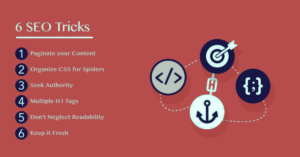How to Rank #1 on Google: A Comprehensive Guide

How to Rank #1 on google? Achieving the coveted #1 ranking on Google is a goal for many website owners and digital marketers. Although this is a daunting task, with the right strategy and tools, it is definitely possible. This guide will walk you through the steps necessary to improve your website’s SEO and climb to the top of search engine results.
Table of Contents
How to Rank #1 on Google: Understand Google’s Ranking Factors
Google uses over 200 ranking factors to determine where websites appear in search results. Here are some of the most important of these factors:
I. Content Quality: Google prioritizes high-quality, relevant content that answers users’ search queries effectively.
II. Backlinks: Links from other reputable websites signal to Google that your content is trustworthy and valuable.
III. User Experience: Websites that load quickly, are mobile-friendly, and provide a good user experience tend to rank higher.
IV. On-Page SEO: Proper use of keywords, meta tags, and headers is crucial for SEO success.
Understanding these factors helps in creating a roadmap for your SEO strategy.
How to Rank #1 on Google: Perform Keyword Research
Keyword research is the foundation of any SEO strategy. Identifying the right keywords to target will determine the direction of your content and on-page optimization. Here’s how to do it:
I. Use Keyword Tools: Utilize tools like Google Keyword Planner, Ahrefs, or SEMrush to find keywords relevant to your niche.
II. Analyze Competitors: Look at the keywords your competitors are ranking for, and identify opportunities to target less competitive but relevant keywords.
III. Focus on Long-Tail Keywords: These are less competitive, more specific phrases that often convert better because they match user intent more closely.
How to Rank #1 on Google: Create High-Quality, Relevant Content
Content is king in SEO. To rank #1 on Google, your content must be better than anything else out there. Here’s how to create content that ranks:
I. Write In-Depth Content: Longer articles that thoroughly cover a topic tend to rank better. Aim for at least 1,500-2,000 words.
II. Incorporate Keywords Naturally: Use your target keywords in titles, headings, and throughout the content. Avoid keyword stuffing.
III. Update Regularly: Keep your content fresh by updating it with new information, statistics, or perspectives.
IV. Use Multimedia: Incorporate images, videos, infographics, and other media to enhance the user experience and engagement.
How to Rank #1 on Google: Optimize On-Page SEO
On-page SEO refers to the elements on your website that you can control directly. Proper on-page optimization is crucial for ranking #1 on Google. Focus on the following:
I. Title Tags: Include your target keyword in the title tag and make it compelling to encourage clicks.
II. Meta Descriptions: Write a concise meta description that includes the target keyword and entices users to click.
III. Header Tags (H1, H2, H3): Use headers to structure your content logically. Include keywords in these tags when appropriate.
IV. Internal Linking: Link to other relevant pages on your site to help Google understand the structure of your website.
V. Image Alt Text: Optimize images by including descriptive alt text that contains your target keywords.
How to Rank #1 on Google: Improve User Experience (UX)
Google prioritizes websites that provide a great user experience. To improve UX:
I. Ensure Mobile Responsiveness: Your website should be fully functional and easy to navigate on mobile devices.
II. Increase Page Speed: Use tools like Google PageSpeed Insights to identify and fix issues that slow down your site.
III. Simplify Navigation: Make sure users can easily find what they’re looking for. A clear, intuitive navigation structure is key.
IV. Reduce Bounce Rate: Create engaging content and a clean design to keep users on your site longer.
How to Rank #1 on Google: Build High-Quality Backlinks
Backlinks are one of the most powerful ranking factors. When reputable websites link to your content, it signals to Google that your site is authoritative and trustworthy. Here’s how to build backlinks:
I. Guest Blogging: Write articles for other websites in your niche and include links back to your site.
II. Create Shareable Content: Content that is original, data-driven, or highly informative is more likely to be shared and linked to.
III. Engage in Outreach: Contact bloggers, journalists, and influencers in your industry to promote your content and request backlinks.
IV. Monitor Backlinks: Use tools like Ahrefs or Moz to track your backlinks and disavow any that are low quality or spammy.
How to Rank #1 on Google: Leverage Local SEO
If you run a local business, local SEO is essential for ranking #1 on Google. Here’s how to optimize for local search:
I. Claim Your Google My Business Listing: Ensure that your business information is accurate and complete.
II. Get Reviews: Encourage satisfied customers to leave positive reviews on Google and other review sites.
III. Use Local Keywords: Include local keywords (e.g., “best coffee shop in Seattle”) in your content and meta tags.
IV. Build Local Citations: Ensure your business is listed in local directories and that the information is consistent across all platforms.
How to Rank #1 on Google: Utilize Technical SEO
Technical SEO involves optimizing the technical aspects of your website to improve its visibility on Google. Key areas to focus on include:
I. XML Sitemap: Ensure that your site has an XML sitemap submitted to Google Search Console.
II. Robots.txt File: Check that your robots.txt file is correctly configured to allow search engines to crawl your site.
III. Fix Crawl Errors: Regularly monitor Google Search Console for crawl errors and fix them promptly.
IV. Use HTTPS: Secure your site with HTTPS, as Google favors secure websites.
V. Structured Data Markup: Implement schema markup to help search engines better understand your content and improve your chances of appearing in rich snippets.
How to Rank #1 on Google: Analyze and Track Your Progress
SEO is not a one-time effort; it requires continuous monitoring and adjustment. Use the following tools to track your progress:
I. Google Analytics: Monitor traffic, user behavior, and conversion rates.
II. Google Search Console: Track your site’s performance in search results and fix any issues.
III. SEO Tools: Use tools like Ahrefs, SEMrush, or Moz to track keyword rankings, backlinks, and other important metrics.
Regularly analyze your data to understand what’s working and where there’s room for improvement.
How to Rank #1 on Google: Stay Updated with SEO Trends
SEO is constantly evolving, with Google frequently updating its algorithms. To maintain your ranking, stay informed about the latest SEO trends and best practices:
I. Follow Industry Blogs: Read blogs like Moz, Search Engine Journal, and Ahrefs for the latest SEO news and tips.
II. Participate in SEO Communities: Join forums, groups, and online communities where SEO professionals share insights and strategies.
III. Experiment and Adapt: Test new techniques and strategies, and be prepared to adapt your approach as the SEO landscape changes.
Conclusion
Ranking #1 on Google is a challenging but achievable goal with the right strategy. By understanding Google’s ranking factors, optimizing your content and website, building quality backlinks, and staying updated with SEO trends, you can improve your chances of reaching that coveted top spot. Remember, SEO is a long-term investment, and consistency is key. Start implementing these strategies today, and watch your website climb the ranks of Google search results!







